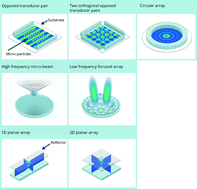Dynamic-field devices for the ultrasonic manipulation of microparticles
Abstract
The use of acoustic radiation forces in lab-on-a-chip environments has seen a rapid development in recent years. Operations such as particle sieving, sorting and characterisation are becoming increasingly common with a range of applications in the biomedical sciences. Traditionally, these applications rely on static patterns of ultrasonic pressure and are often collectively referred to as ultrasonic standing wave devices. Recent years have also seen the emergence of devices which capitalise on dynamic and reconfigurable ultrasonic fields and these are the subject of this review. Dynamic ultrasonic fields lead to acoustic radiation forces that change with time. They have opened up the possibility of performing a wide range of manipulations such as the transport and rotation of individual particles or agglomerates. In addition, they have led to device reconfigurability, i.e. the ability of a single lab-on-a-chip device to perform multiple functions. This opens up the possibility of channel-less microfluidic devices which would have many applications, for example in biosensing and microscale assembly. This paper reviews the current state of the field of dynamic and reconfigurable ultrasonic particle manipulation devices and then discusses the open problems and future possibilities.


 Please wait while we load your content...
Please wait while we load your content...